Abstract
We evaluated changes of maximum expiratory flow-volume (MEFV) curves and of partial expiratory flow-volume (PEFV) curves caused by bronchoconstrictor drugs and dust, and compared these to the reverse changes induced by a bronchodilator drug in previously bronchoconstricted subjects. Measurements of maximum flow at constant lung inflation (i.e. liters thoracic gas volume) showed larger changes, both after constriction and after dilation, than measurements of peak expiratory flow rate, 1 sec forced expiratory volume and the slope of the effort-independent portion of MEFV curves. Changes of flow rates on PEFV curves (made after inspiration to mid-vital capacity) were usually larger than those of flow rates on MEFV curves (made after inspiration to total lung capacity). The decreased maximum flow rates after constrictor agents are not caused by changes in lung static recoil force and are attributed to narrowing of small airways, i.e., airways which are uncompressed during forced expirations. Changes of maximum expiratory flow rates at constant lung inflation (e.g. 60% of the control total lung capacity) provide an objective and sensitive measurement of changes in airway caliber which remains valid if total lung capacity is altered during treatment.
Full text
PDF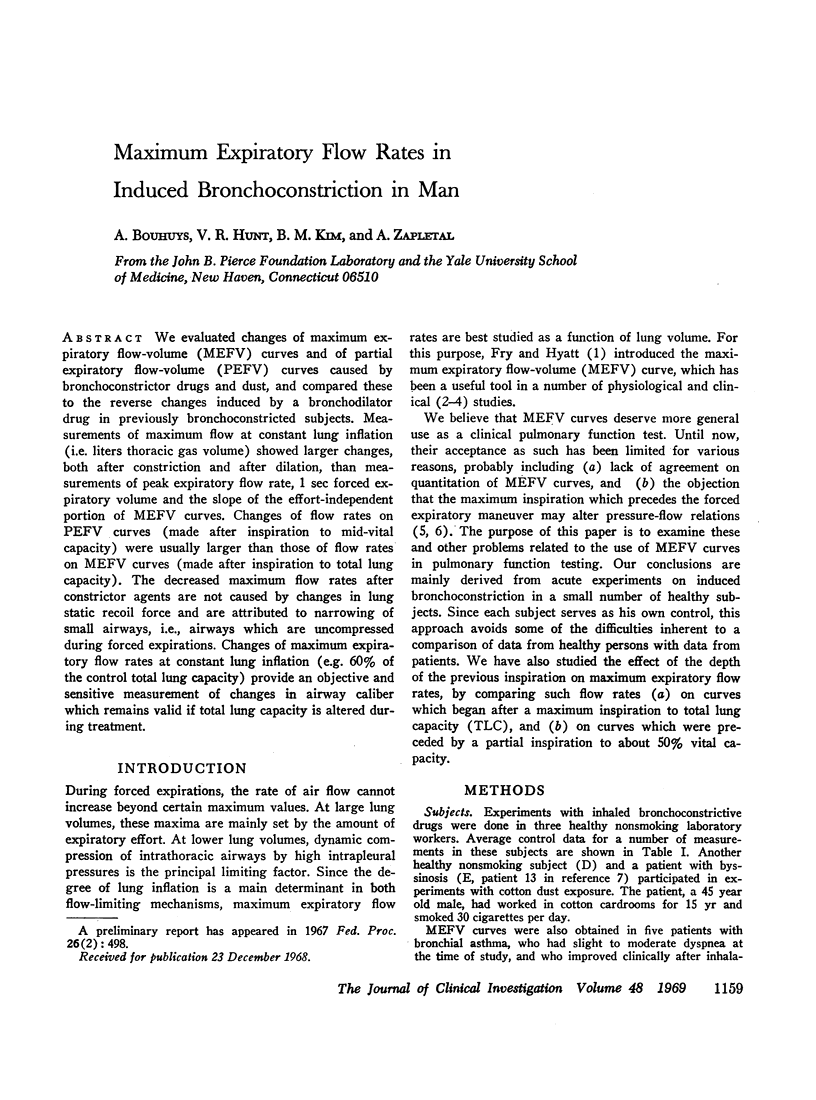
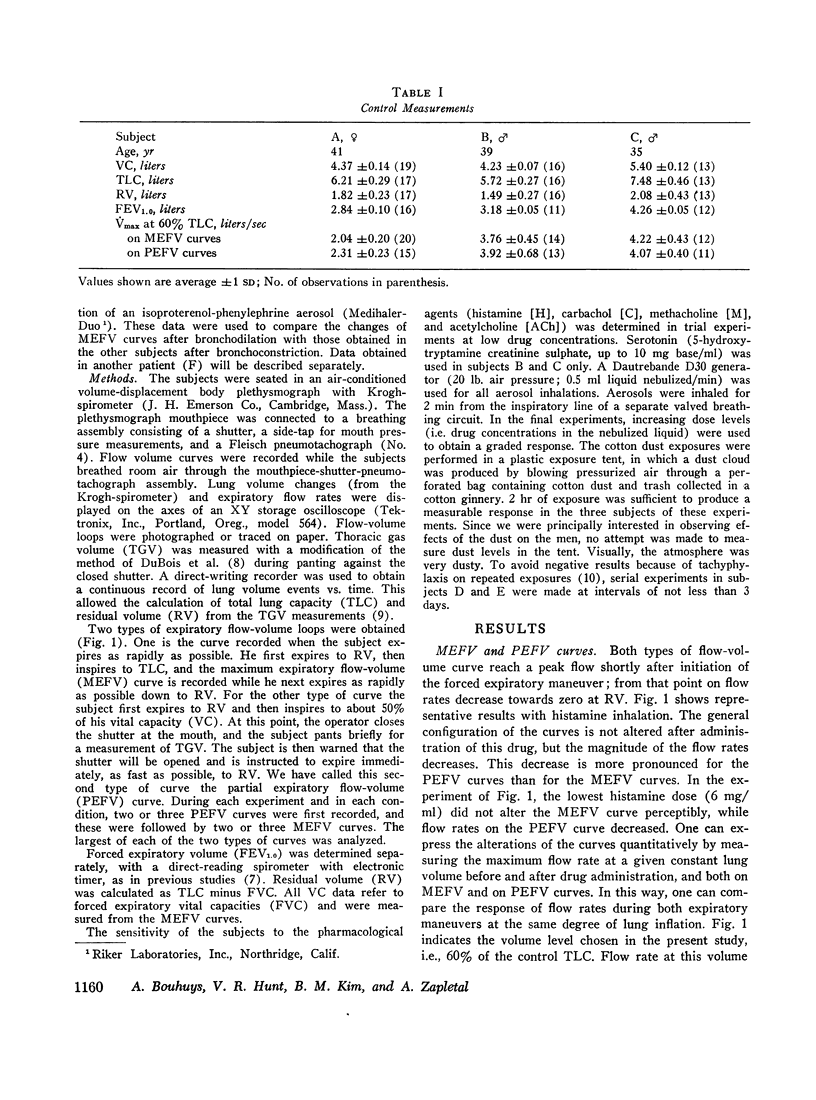

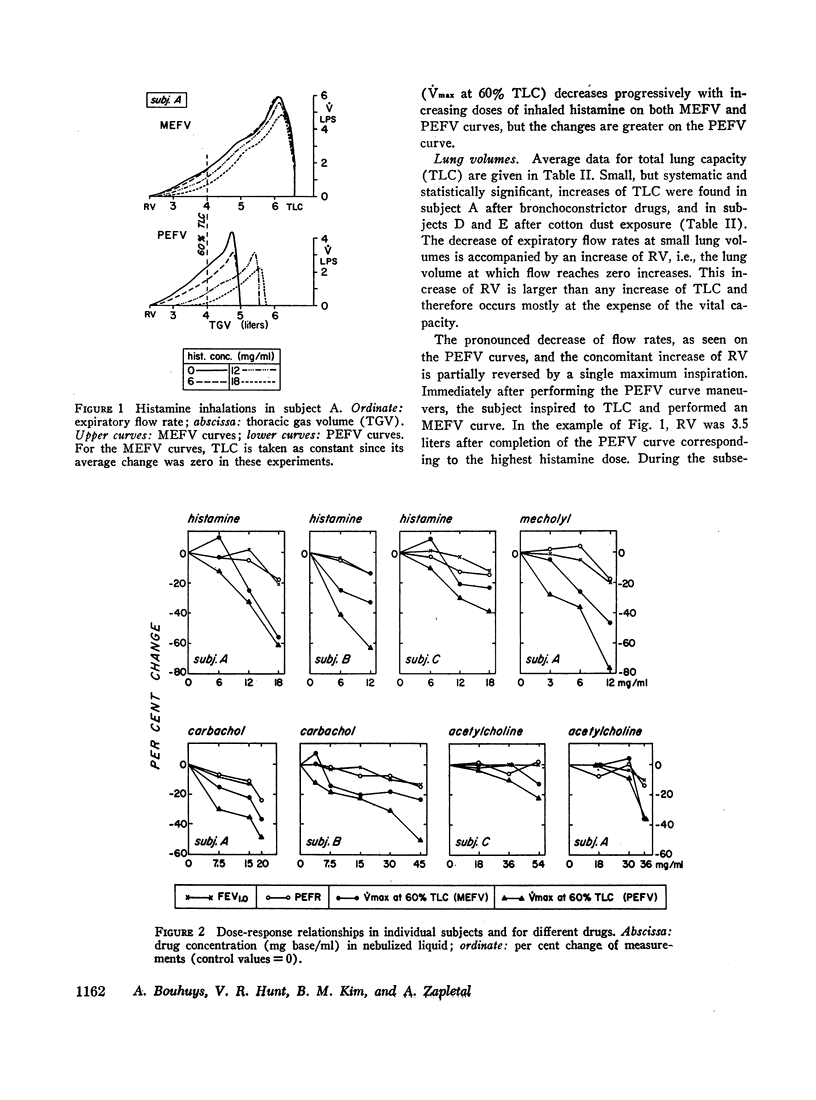
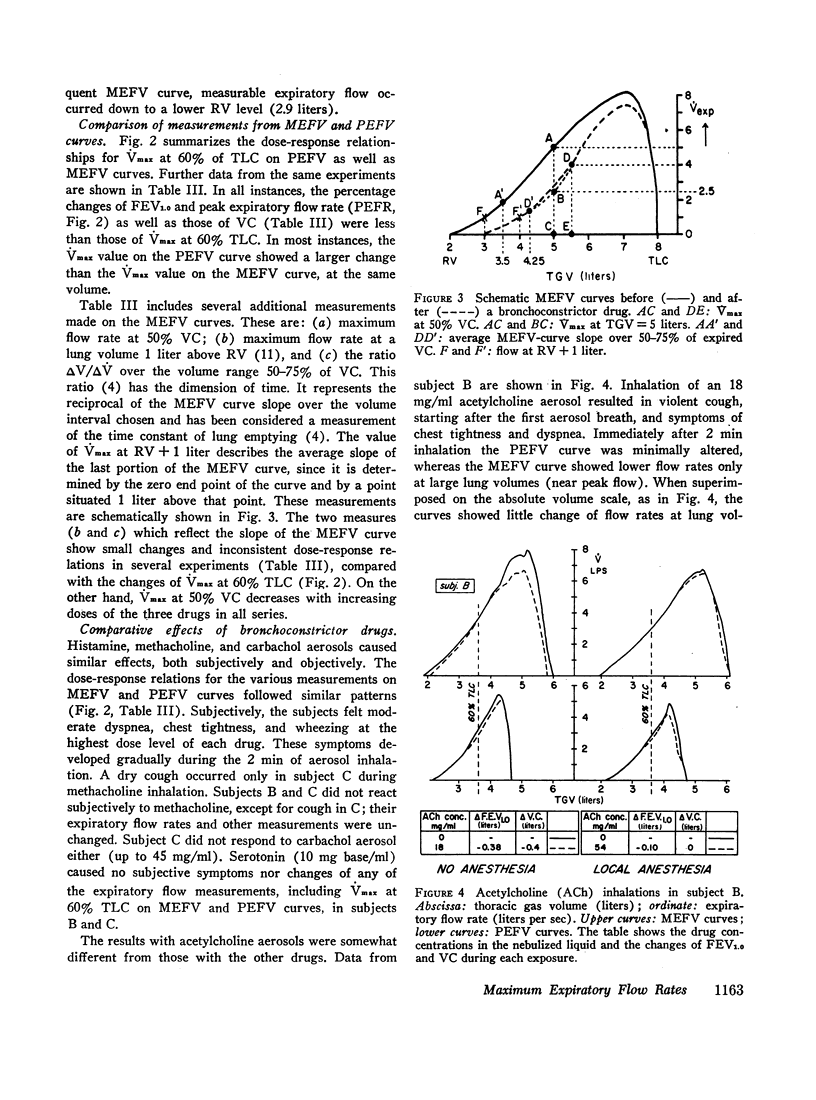

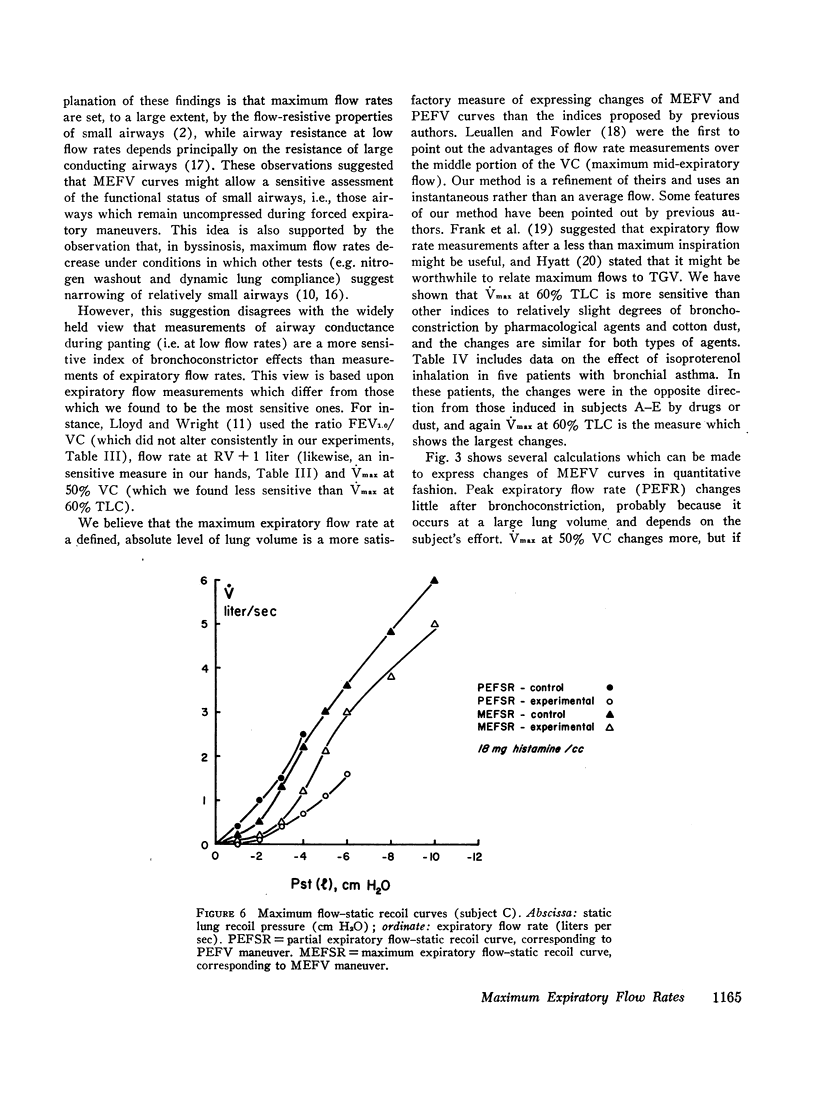
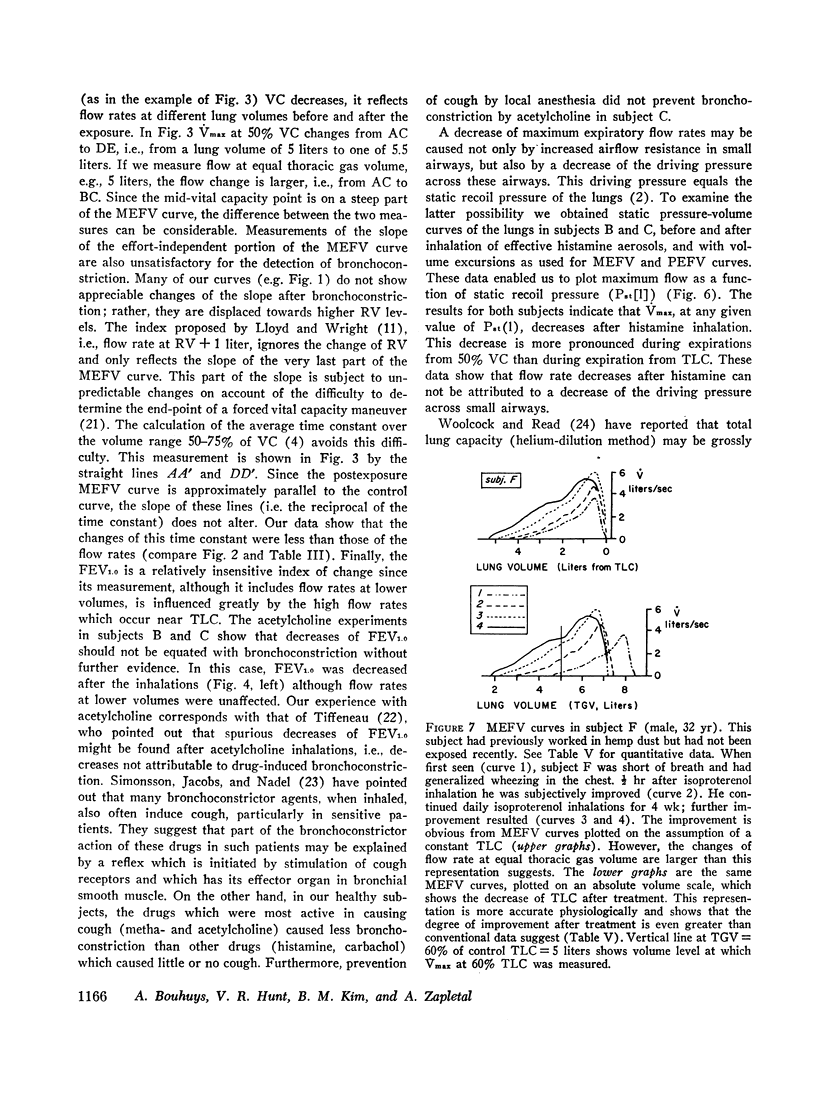
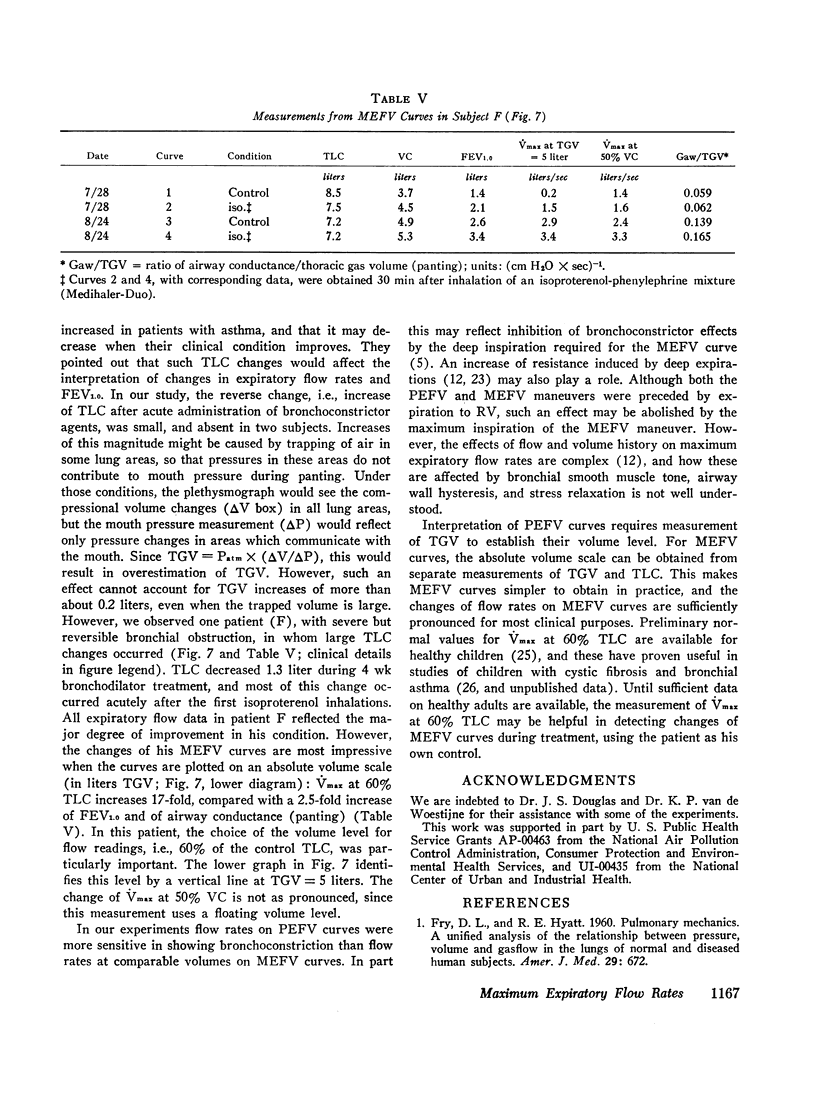

Selected References
These references are in PubMed. This may not be the complete list of references from this article.
- BOUHUYS A., LINDELL S. E., LUNDIN G. Experimental studies on byssinosis. Br Med J. 1960 Jan 30;1(5169):324–326. doi: 10.1136/bmj.1.5169.324. [DOI] [PMC free article] [PubMed] [Google Scholar]
- Bernstein L., Shepard R. H., Jr High resolution display for variables in volume-displacement body plethysmography. J Appl Physiol. 1966 Mar;21(2):721–724. doi: 10.1152/jappl.1966.21.2.721. [DOI] [PubMed] [Google Scholar]
- Bouhuys A., Heaphy L. J., Jr, Schilling R. S., Welborn J. W. Byssinosis in the United States. N Engl J Med. 1967 Jul 27;277(4):170–175. doi: 10.1056/NEJM196707272770402. [DOI] [PubMed] [Google Scholar]
- Bouhuys A., Jonson B. Alveolar pressure, airflow rate, and lung inflation in man. J Appl Physiol. 1967 Jun;22(6):1086–1100. doi: 10.1152/jappl.1967.22.6.1086. [DOI] [PubMed] [Google Scholar]
- Bouhuys A., Van de Woestijne K. P. Restrictive versus obstructive ventilatory impairment. Lancet. 1968 Aug 10;2(7563):352–352. doi: 10.1016/s0140-6736(68)90561-8. [DOI] [PubMed] [Google Scholar]
- DUBOIS A. B., BOTELHO S. Y., BEDELL G. N., MARSHALL R., COMROE J. H., Jr A rapid plethysmographic method for measuring thoracic gas volume: a comparison with a nitrogen washout method for measuring functional residual capacity in normal subjects. J Clin Invest. 1956 Mar;35(3):322–326. doi: 10.1172/JCI103281. [DOI] [PMC free article] [PubMed] [Google Scholar]
- FRANK N. R., AMDUR M. O., WORCESTER J., WHITTENBERGER J. L. Effects of acute controlled exposure to SO2 on respiratory mechanics in healthy male adults. J Appl Physiol. 1962 Mar;17:252–258. doi: 10.1152/jappl.1962.17.2.252. [DOI] [PubMed] [Google Scholar]
- FRY D. L., HYATT R. E. Pulmonary mechanics. A unified analysis of the relationship between pressure, volume and gasflow in the lungs of normal and diseased human subjects. Am J Med. 1960 Oct;29:672–689. doi: 10.1016/0002-9343(60)90100-5. [DOI] [PubMed] [Google Scholar]
- HYATT R. E. The interrelationships of pressure, flow, and volume during various respiratory maneuvers in normal and emphysematous subjects. Am Rev Respir Dis. 1961 May;83:676–683. doi: 10.1164/arrd.1961.83.5.676. [DOI] [PubMed] [Google Scholar]
- LEUALLEN E. C., FOWLER W. S. Maximal midexpiratory flow. Am Rev Tuberc. 1955 Dec;72(6):783–800. doi: 10.1164/artpd.1955.72.6.783. [DOI] [PubMed] [Google Scholar]
- LLOYD T. C., Jr Bronchoconstriction in man following single deep inspirations. J Appl Physiol. 1963 Jan;18:114–116. doi: 10.1152/jappl.1963.18.1.114. [DOI] [PubMed] [Google Scholar]
- LLOYD T. C., Jr, WRIGHT G. W. Evaluation of methods used in detecting changes of airway resistance in man. Am Rev Respir Dis. 1963 Apr;87:529–537. doi: 10.1164/arrd.1963.87.4.529. [DOI] [PubMed] [Google Scholar]
- Lapp N. L., Hyatt R. E. Some factors affecting the relationship of maximal expiratory flow to lung volume in health and disease. Dis Chest. 1967 May;51(5):475–481. doi: 10.1378/chest.51.5.475. [DOI] [PubMed] [Google Scholar]
- Macklem P. T., Mead J. Resistance of central and peripheral airways measured by a retrograde catheter. J Appl Physiol. 1967 Mar;22(3):395–401. doi: 10.1152/jappl.1967.22.3.395. [DOI] [PubMed] [Google Scholar]
- Mead J., Turner J. M., Macklem P. T., Little J. B. Significance of the relationship between lung recoil and maximum expiratory flow. J Appl Physiol. 1967 Jan;22(1):95–108. doi: 10.1152/jappl.1967.22.1.95. [DOI] [PubMed] [Google Scholar]
- NADEL J. A., TIERNEY D. F. Effect of a previous deep inspiration on airway resistance in man. J Appl Physiol. 1961 Jul;16:717–719. doi: 10.1152/jappl.1961.16.4.717. [DOI] [PubMed] [Google Scholar]
- Pride N. B., Permutt S., Riley R. L., Bromberger-Barnea B. Determinants of maximal expiratory flow from the lungs. J Appl Physiol. 1967 Nov;23(5):646–662. doi: 10.1152/jappl.1967.23.5.646. [DOI] [PubMed] [Google Scholar]
- Simonsson B. G., Jacobs F. M., Nadel J. A. Role of autonomic nervous system and the cough reflex in the increased responsiveness of airways in patients with obstructive airway disease. J Clin Invest. 1967 Nov;46(11):1812–1818. doi: 10.1172/JCI105671. [DOI] [PMC free article] [PubMed] [Google Scholar]
- Takishima T., Grimby G., Graham W., Knudson R., Macklem P. T., Mead J. Flow-volume curves during quiet breathing, maximum voluntary ventilation, and forced vital capacities in patients with obstructive lung disease. Scand J Respir Dis. 1967;48(3):384–393. [PubMed] [Google Scholar]
- Woolcock A. J., Read J. Lung volumes in exacerbations of asthma. Am J Med. 1966 Aug;41(2):259–273. doi: 10.1016/0002-9343(66)90021-0. [DOI] [PubMed] [Google Scholar]
- Zapletal A., Motoyama E. K., Van De Woestijne K. P., Hunt V. R., Bouhuys A. Maximum expiratory flow-volume curves and airway conductance in children and adolescents. J Appl Physiol. 1969 Mar;26(3):308–316. doi: 10.1152/jappl.1969.26.3.308. [DOI] [PubMed] [Google Scholar]


